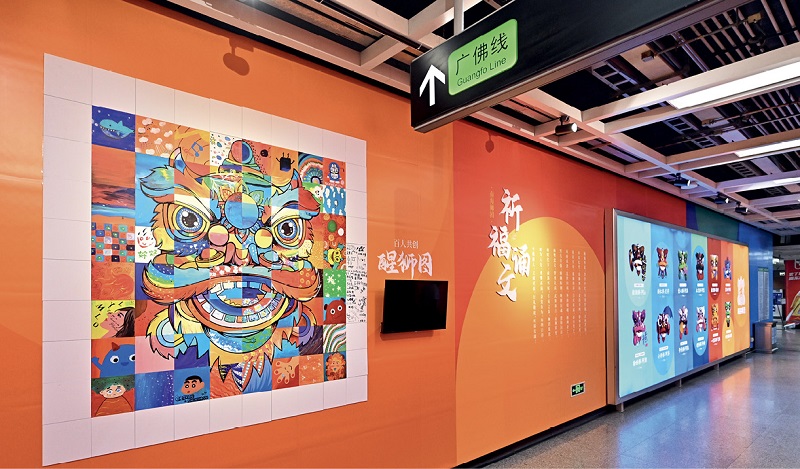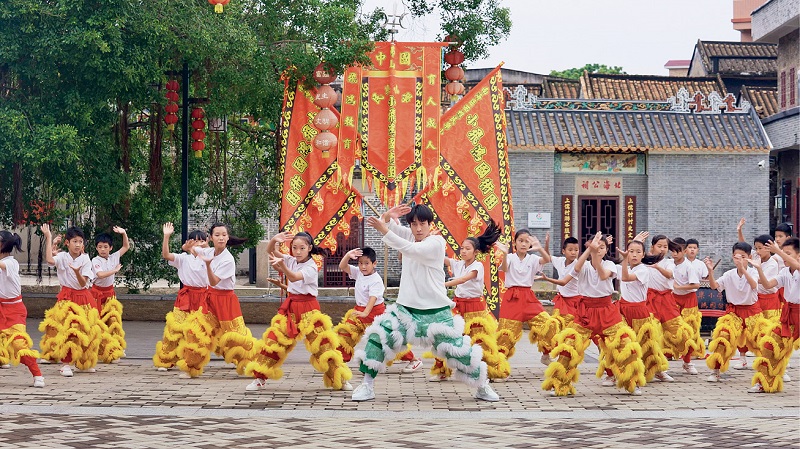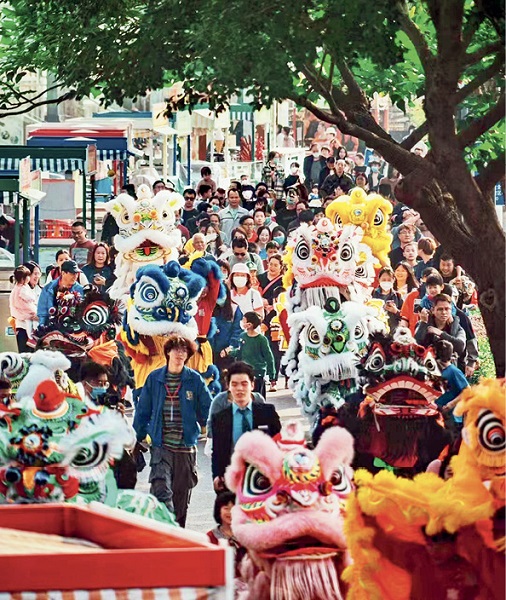From cultural and creative products to performance, animation, and avant-garde technology, the time-honored Guangdong lion dance has always been on the new stage of China chic.

Leigang subway station in Nanhai District, Fo-shan City, is decorated with elements of lion dance.
As the sounds of drums and gongs reached their climax, a cute big-headed ornate stylized lion leading 12 others interacted happily with spectators and participants in a lion dance parade in Xiqiao Town, Foshan City, the third largest city in Guangdong Province. Some took out their phones and recorded the joyous moment, and others went up and touched the lion heads to get good fortune. This is a moment when the Nanhai Lion Dance Troupe was celebrating its first birthday.
Gaining Popularity
Xiqiao Town is known as the birthplace of dragon and lion dance in China. Historical records show that local people began to practice dragon and lion dance as a form of Kung fu exercise as early as in the reign of Emperor Jiajing (1522-1566) during the Ming Dynasty (1368-1644). In 2006, the performing art was included in the first batch of China’s National Intangible Cultural Heritage List.
From the movie Once Upon a Time in China 3 three decades ago, to the animation I Am What I Am in 2021, and a brilliant three-minute performance of lion-awakening dance at a celebratory gala in the run-up of the 2022 Chinese New Year presented by Henan TV, the lion dance art has given Xiqiao a widespread reputation. However, when it comes to its inheritance, according to Li Nianzhong, an inheritor of Guangdong lion dance, it is a bumpy road.
“As urbanization advances, the art form has been losing its appeal among the general public,” said Li. In the process, folk performers of lion dance failed to keep up with the times, and there is a lack of creativity and innovation in the performance content and form. As a result, the art form finds it hard to attract teenagers.
To attract people to this art form, Nanhai, the administrative district governing Xiqiao Town, began to make bold innovative moves. From formulating standardized competition and referee rules to holding various events, Nanhai has gradually led the global trend of lion dance competitions. Since 2001, Nanhai has hosted the Wong Fei-Hung Cup National Lion Dance Competition for more than two decades. The event has been praised as a never-ending lion dance feast.
Besides, by integrating martial arts, dance, and music, the overall performance of traditional lion dance is full of theatrics and amusement, and began to attract more audiences.
Nanhai also worked with the Institute for Cultural Creativity of Tsinghua University and launched a special program aiming to awaken the traditional lion dance art. Under the program, 12 representatives out of more than 2,700 extant lion images were selected and became “members” of the Nanhai Lion Dance Troupe. Unlike traditional lion images used in performance, the troupe members were redesigned, and given unique personalities by their performers.
The troupe made its debut on February 26, 2022, attracting many fans, many of whom were young people.
Nanhai District in recent years has been committed to promoting the traditional art form. “We have been working to transform it from pure folk performance to the brand of our city, which integrates performance, competition, and culture,” said Liang Huiyan, head of the Nanhai District cultural authority. “We hope to activate and inherit the art of lion dance, and build a bridge connecting traditional culture with young people.”

Children are performing a lion dance that integrates street dance and pop music, inheriting traditional culture in a way that attracts young people.
Reinvigorating Tradition
In 2020, a short video of an improvisational performance of a sleepy lion went viral online. “Traditionally, there are performances featuring sleepy lions. The video just presented it more life-like, striking a chord among young people and triggering their interest in the lion dance art,” said Huang Zhijia, head of Foshan Guoding Martial Arts Dragon and Lion Group, a lion dance troupe. The lion image also won a cute name – Pizai.
Encouraged by the success of the sleepy lion image, Huang’s team planned another short video about Pizai waiting for his girlfriend on a bridge. “It is novel and the idea is proposed by young people in our team,” Huang said. According to Huang, since the establishment of the lion dance troupe, it has not only presented a series of wonderful performances to the audience, but also brought conceptual innovation to performers. “We should start from the perspective of young people, use the language they understand, and reflect their day-to-day life, so that we can resonate with them and the lion dance art can have a bigger chance of being recognized by them,” said Huang.
I Am What I Am, a Chinese animation released at the end of 2021, received much acclaim among filmgoers, and also set a new box-office record among domestically produced animations released during the peak film-going season of the Chinese New Year. The film presented the art of lion dance with animation. Reasons behind its popularity not only lie in the vitality shown by the protagonists, but also the resilience of traditional culture.
The most gripping part of the animation is the final part. A series of difficult movements in real-life performances staged in Xiqiao are portrayed through modern technology in the animated film, the details of which amazed the audience. “For example, performers of the lion head and lion tail, and the drummers in the film were all inspired by members of our troupe,” said Li Nianzhong, adding that the troupe also offered guidance on the dance movements and use of props in the film.
Nanhai recently held a theme cultural season, offering people a chance to experience the charm of the lion dance. The 13-week event brought together more than 2,000 young people to contribute their ideas to the development of lion dance art, and attracted more than 200,000 visitors.
In addition, Nanhai also cooperated with mobile game producers and Chinese chic brands to launch game elements, clothes, music, and dance, which were sought after by many gamers.
From cultural and creative products to performance, animation, and avant-garde technology, the time-honored Guangdong lion dance has always been on the new stage of China chic.

Nanhai Lion Dance Troupe interacts happily with local citizens during a parade amid the sounds of gongs and drums.
To the Future
With the rhythmic beats of drums in the background, children in Pingzhou Center Kindergarten, Guicheng residential community, are dressed up as little cute “lions” learning the lion dance from Ah Ping, a female member of the Nanhai Lion Dance Troupe.
Yu Weiguo, head of the Martial Arts Dragon and Lion Association in Guicheng residential community, was the first one who taught lion dance in kindergarten. Yu has been challenging traditional ideas in passing on the art. Traditionally women were not encouraged to perform lion dance. “However, I believe that the development of such an excellent traditional art form does not rely solely on the strength of men. It should also include the participation of women,” said Yu.
In 2005, he travelled all over the country, recruited a group of girls with basic martial arts skills, and established a female lion dance team. The team won gold medals in many world-class competitions, such as the World Lion Dance Championship. Since then, more and more women have taken an interest in the dance.
One day, Yu had a new idea of training children in kindergarten to perform the dance. Since the 1980s, Nanhai has managed to incorporate lion dance into local education, and later developed more than 800 lion dance teams in 65 primary and secondary schools in the district, but the art had never been introduced to children in kindergartens.
“It is a challenging task to teach kindergarten children complicated lion dance movements, but we can start from the simple, such as imitating the characteristic steps and performance etiquettes. In this way, we can expose them to the art and spur their interest,” said Yu. He began to train the first batch of teachers at Pingzhou Center Kindergarten in 2021. Before long, teachers from more than 20 kindergartens came to learn the art. After completing the training, they combined the characteristics of their kindergarten to recreate and promote the art on a broader sphere.
“Now, many children aged three or four can perform simple dance steps to the beats of the drum. Grandparents play drums, children dance, and the entire family has a good time, which naturally forms an enabling environment in the family for promoting the lion dance art,” Yu said. Now, Yu is frequently invited to schools in Shanghai, and places in Zhejiang Province among others to give lectures and attend events on promoting the lion dance art.
Art Field Nanhai Guangdong, a top-level international cultural festival, welcomed a young guest from Shanghai in November 2022. He was intrigued after seeing a short video of lion dance exercise online, and began to teach himself how to do it. He then taught every other child in his kindergarten. His mother specially brought him to Nanhai in order to let him have a deeper understanding of the lion dance art.
“The lion dance exercise is quite rousing. Integrating the traditional art with pop music and dance, the exercise has gained widespread popularity among children as expected,” said Liang Huiyan.
Liang said that the exercise has been included in breaktime activities of all primary and secondary schools in Xiqiao Town. It even has become a special sports program in some kindergartens in other provinces. “In pedagogical sense, we carry the mission of inheriting traditional culture and promoting the China chic. The future of lion dance is in schools,” Liang said.